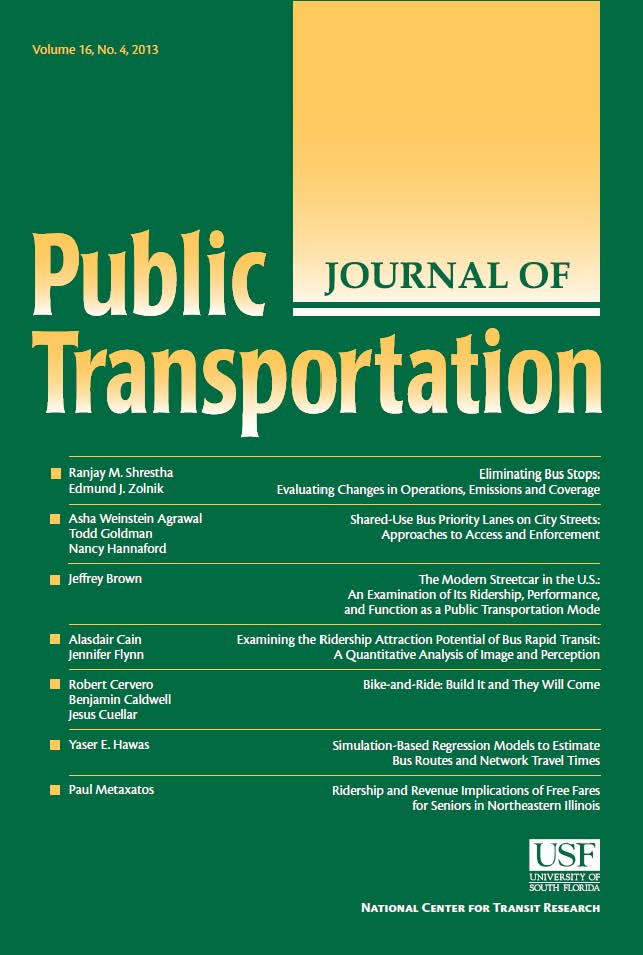Bit by bit: A method for using bus data to develop plan bus priority interventions in Portland, Oregon, USA
IF 2
4区 工程技术
Q3 TRANSPORTATION
引用次数: 0
Abstract
Bus Priority Interventions are small-scale changes that improve bus speed and reliability. These include changes to street geometry, bus stops, and traffic signals. Automated Vehicle Location-Automated Passenger Counting (AVL-APC) data can help transit agencies by providing insight into bus location, speed, and passenger volumes. This work proposes an end-to-end methodology for using AVL-APC data to create a concept design for bus priority interventions on a bus corridor. The proposed method is illustrated by analyzing a bus route in Portland, Oregon. This mixed-methods approach paired quantitative data analysis with site visits to identify what was causing delay on the route and suggest targeted interventions. Scenario analysis of historical trip data was employed to predict the impact of different interventions. Historical trips that fell into two different scenarios were compared: a delay scenario (where a specific delay-inducing event occurred, like a red light) and a non-delay scenario (where that event did not occur). This end-to-end methodology could be used by transit agencies and transportation planners to quickly assess different corridors and interventions, diagnose problems, and determine which projects would create the greatest customer and financial benefits. Employing this approach could help planners prioritize time and resources to ensure that the highest impact projects are pursued.
一点一点:美国俄勒冈州波特兰市利用公交数据制定公交优先干预计划的方法
总线优先干预是提高总线速度和可靠性的小规模改变。其中包括街道几何形状、公交车站和交通信号的变化。自动车辆定位-自动乘客计数(AVL-APC)数据可以通过提供公交车位置、速度和乘客数量的信息来帮助运输机构。这项工作提出了一种端到端方法,用于使用AVL-APC数据来创建公交走廊上公交优先干预的概念设计。本文以俄勒冈州波特兰市的一条公交线路为例进行了分析。这种混合方法将定量数据分析与实地考察相结合,以确定导致路线延误的原因,并提出有针对性的干预措施。利用历史出行数据进行情景分析,预测不同干预措施的影响。研究人员比较了两种不同情况下的历史行程:延迟情况(发生了特定的导致延迟的事件,如红灯)和非延迟情况(没有发生该事件)。这种端到端的方法可以被运输机构和交通规划者用来快速评估不同的走廊和干预措施,诊断问题,并确定哪些项目将创造最大的客户和经济效益。采用这种方法可以帮助规划者优先考虑时间和资源,以确保执行影响最大的项目。
本文章由计算机程序翻译,如有差异,请以英文原文为准。
求助全文
约1分钟内获得全文
求助全文
来源期刊

Journal of Public Transportation
TRANSPORTATION-
CiteScore
6.40
自引率
0.00%
发文量
29
审稿时长
26 days
期刊介绍:
The Journal of Public Transportation, affiliated with the Center for Urban Transportation Research, is an international peer-reviewed open access journal focused on various forms of public transportation. It publishes original research from diverse academic disciplines, including engineering, economics, planning, and policy, emphasizing innovative solutions to transportation challenges. Content covers mobility services available to the general public, such as line-based services and shared fleets, offering insights beneficial to passengers, agencies, service providers, and communities.
 求助内容:
求助内容: 应助结果提醒方式:
应助结果提醒方式:


